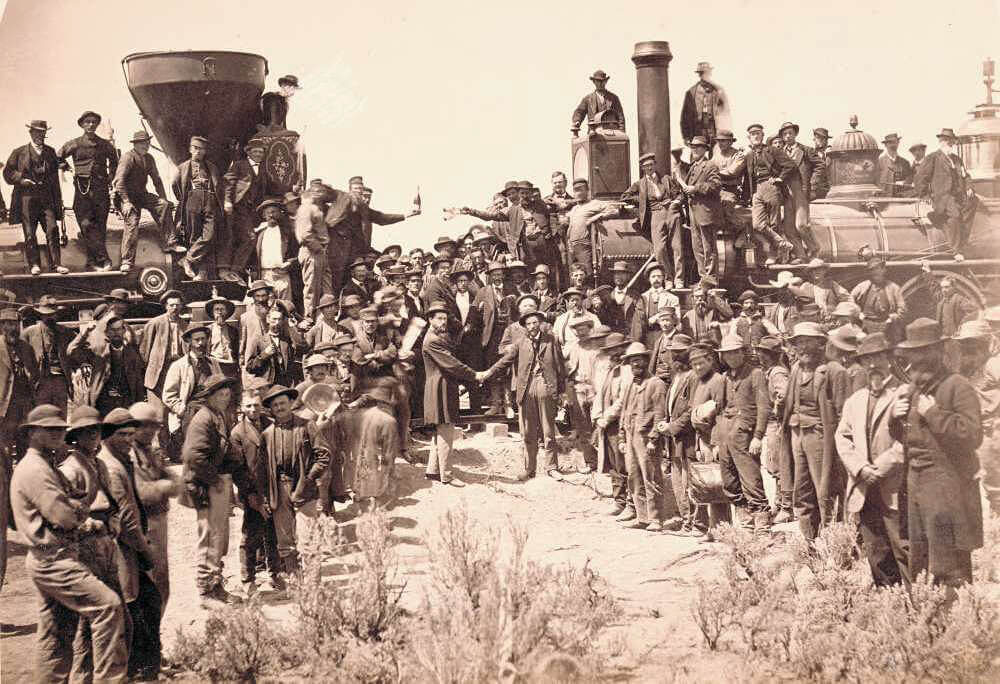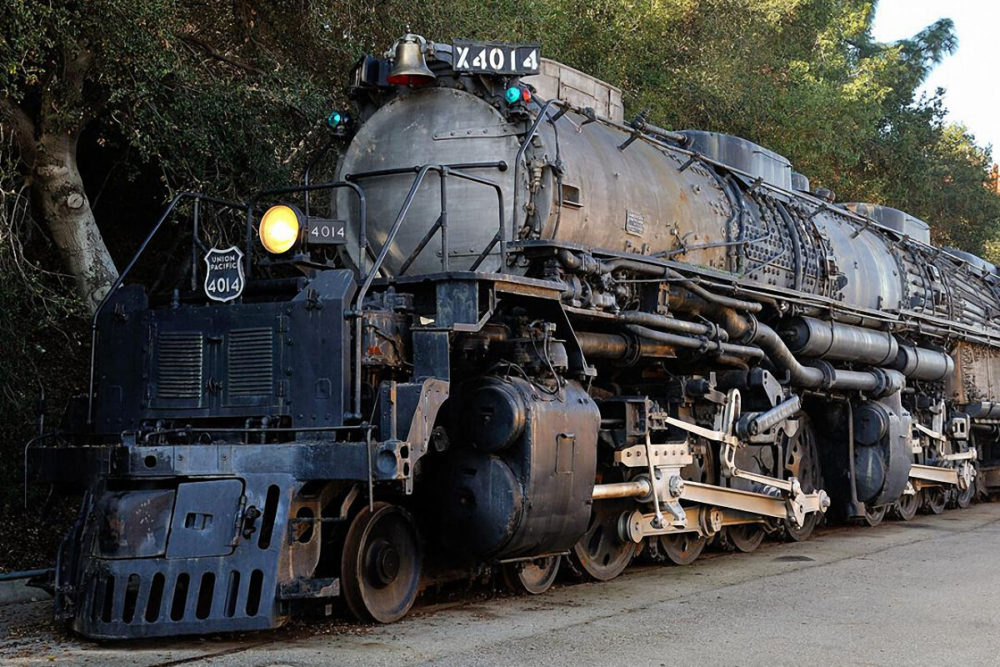On what is being called the Golden Spike celebration, a week from now — on Friday, May 10th … rail historians and railfans alike will gather at Promontory Summit in northern Utah to commemorate the 150th anniversary of the completion of the first transcontinental railway reaching the west coast of the United States.
As you see in this actual photo taken on that day in 1869, it shows the two locomotives nose-to-nose … coming west from Nebraska, Union Pacific locomotive 119 and heading east from California, the Central Pacific locomotive known as Jupiter

This historic photo, taken by Andrew J. Russell, is titled “East and West Shaking Hands at Laying Last Rail, 1869” and is shown courtesy Union Pacific Railroad Museum. Looking closely, in the center of the picture, from the left, shaking hands, are Samuel S. Montague, chief engineer of the Central Pacific Railroad, and General Grenville M. Dodge, chief engineer of the Union Pacific Railroad.
Earlier in the day, workers from each company had set in place the last section of each railroad’s rail so that they abutted each other … and the ceremonial “golden spike” was driven into place, certifying completion of the “transcontinental railroad,” fulfilling the terms of the United States government’s Pacific Railroad Act, which had been signed into law by President Abraham Lincoln on July 1st in 1862. This was necessary, as much of the cost of constructing the 1,500+-mile line was financed through U. S. government bonds.
Today, while trains no longer run through here (I’ll discuss this shortly), the National Park Service does maintain a section of track at this location on which replicas of the Jupiter and Number 119 operate during the summer months.
The McQueen’s Jupiter Postage Stamp
According to the U. S. Stamp Gallery website: The Jupiter, designed by Walter McQueen and built in 1868, found its way into the history books by accident when one of the locomotives scheduled to be on hand for the driving of the Golden Spike struck a fifty-foot log lying next to the track and was disabled. The Jupiter, in only its sixth week of service, was pressed into action and arrived at Promontory on the evening of May 7, 1869.
This stamp was issued on July 28, 1994 … one of a set of five. Why not on May 10th, the anniversary of the driving of the Golden Spike? Good question.
You can follow the story of the route and its building by visiting this Union Pacific Railroad Golden Spike tribute site.
Bypassing Promontory Summit
As for the national rail network bypassing Promontory Summit … in the world of railroading, it was simply a poor route, due to steep grades and tight curves … the last two things railroads desire to face, but chosen due to a need to go around the Great Salt Lake.
However, after only thirty-some years had passed, the Southern Pacific Company — which had taken over the Central Pacific Railroad — constructed a new route across the Lake utilizing a nearly 12-mile long wooden trestle, eliminating the need to go through Promontory Summit. The change cut 44 miles off the original route and also significantly decreased curvature and grades. (In 1942, the remaining rails and spikes along the original route were pulled up, with the scrap metal contributed to the War effort.)
Little Known Fact…
Here’s a little trivia about there being a true “transcontinental railroad” in 1869 — even with the link-up at Promontory Summit … it didn’t exist. There was no way for a train to travel by rail all the way from the East Coast to California
The Union Pacific rails began heading west from Omaha, Nebraska. Meanwhile, the most western point that the eastern rail network reached was Council Bluffs, Iowa. If you live in that region or know your American geography, you recognize these are adjoining cities. However, what’s between them? The Missouri River! And, a railroad bridge across it had not yet been built.
The only rail crossing of the Missouri River prior to March 22, 1872 — when the first bridge between Omaha and Council Bluffs to carry rail traffic opened — was via the Hannibal Bridge at Kansas City. And, even that route wouldn’t be available until August 15th, 1870, when tracks connecting through Strasburg, Colorado and Denver opened, permitting trains to link up with the Union Pacific line west at Cheyenne, Wyoming.
This Week’s Celebration and Live Event
That’s all for history … but one more note related to next week’s celebration:
On Thursday, the 9th … one day prior to the ceremonies at Promontory … The Union Pacific’s two large operating steam locomotives — #844 and the newly-restored #4014, known as the Big Boy, the largest steam locomotive ever built — will be on display at Ogden’s Union Station as part of the City of Ogden’s participation in the ‘transcontinental railroad” 150th anniversary celebration.
Recently, the Union Pacific Railroad posted this information: “Union Pacific will be streaming the ceremonies live via the UP Facebook page. If you haven’t already “liked” our Facebook page, do it today. You’ll be notified as soon as the cameras start rolling.”
Also, if you would love to see this huge beast in person, there are seven of them on public display in various cities around the country. They can be found in St. Louis, Missouri; Dallas, Texas; Omaha, Nebraska; Denver, Colorado; Steamtown at Scranton, Pennsylvania; Green Bay, Wisconsin; and Cheyenne, Wyoming.
And that’s the story folks, about what’s happening in Utah … celebrating the anniversary of a major event in the early history of railroading in America. Railroads, which I’m sure you recognize, have played a huge role in the building of America, beginning with their birth nearly two centuries ago and continuing right through today!
If you’re interested in learning more of the background surrounding the transcontinental railroad project, the Trains magazine people are offering a collections of videos and print materials which will provide that information.
For the next two week in this space, we return to the subject of Radio and bring you the remaining two chapters in the saga of A Radio Station and its Mistress, as told by Richard Pack with added thoughts and views from yours truly.





